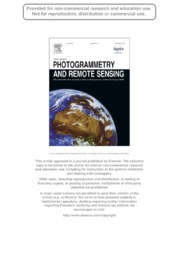A comparative analysis of ALOS PALSAR L-band and RADARSAT-2 C-band data for land-cover classification in a tropical moist region.
A comparative analysis of ALOS PALSAR L-band and RADARSAT-2 C-band data for land-cover classification in a tropical moist region.
Resumo: This paper explores the use of ALOS (Advanced Land Observing Satellite) PALSARL-band (Phased Array type L-band Synthetic Aperture Radar) and RADARSAT-2 C-band data for land-cover classification in a tropical moist region. Transformed divergence was used to identify potential textural images which were calculated with the gray-level co-occurrence matrix method. The standard deviation of selected textural images and correlation coefficients between them were then used to determine the best combination of texture images for land-cover classification. Classification results based on different scenarios with maximum likelihood classifier were compared. Based on the identified best scenarios, different classification algorithms ? maximum likelihood classifier, classification tree analysis, Fuzzy ARTMAP (a neural-network method), k-nearest neighbor, object-based classification, and support vector machine were compared for examining which algorithm was suitable for land-cover classification in the tropical moist region. This research indicates that the combination of radiometric images and their textures provided considerably better classification accuracies than individual datasets. The L-band data provided much better landcover classification than C-band data but neither L-band nor C-band was suitable for fine land-cover classification system, no matter which classification algorithm was used. L-band data provided reasonably good classification accuracies for coarse land-cover classification system such as forest, succession, agropasture, water, wetland, and urban with an overall classification accuracy of 72.2%, but C-band data provided only 54.7%. Compared to the maximum likelihood classifier, both classification tree analysis and Fuzzy ARTMAP provided better performances, object-based classification and support vector machine had similar performances, and k-nearest neighbor performed poorly. More research should address the use of multitemporal radar data and the integration of radar and optical sensor data for improving land-cover classification.
Ano de publicação: 2012
Tipo de publicação: Artigo de periódico
Unidade: Embrapa Territorial
Palavras-chave: ALOS PALSAR, Amazon, Land-cover classification, RADARSAT, texture
Observações
1 - Por padrão são exibidas publicações dos últimos 20 anos. Para encontrar publicações mais antigas, configure o filtro ano de publicação, colocando o ano a partir do qual você deseja encontrar publicações. O filtro está na coluna da esquerda na busca acima.
2 - Para ler algumas publicações da Embrapa (apenas as que estão em formato ePub), é necessário ter, no celular ou computador, um desses softwares gratuitos. Sistemas Android: Google Play Livros; IOS: iBooks; Windows e Linux: software Calibre.
Acesse outras publicações
Acesse a Base de Dados da Pesquisa Agropecuária (BDPA) para consultar o acervo completo das bibliotecas da Embrapa.

